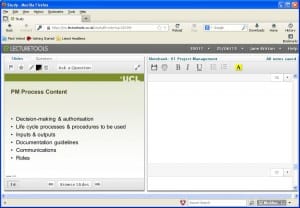Summits and Horizons, 9th June 2014
By Vicki Dale, on 16 June 2014
Last week saw the final session in the current series of Summits and Horizons, a seminar series jointly organised by the Centre for the Advancement in Learning and Teaching (CALT) and E-Learning Environments (ELE). Appropriately, the session focused on the predictions of the 2014 NMC Horizons Report, in the context of use of emerging technologies to support teaching and learning at UCL.
Fiona Strawbridge highlighted the trends, challenges and emerging technologies identified in the report:
| Trends | Challenges | Technologies |
Near term (1-2 years):
Medium term (3-4 years):
Far term (5+ years):
|
Solvable:
Difficult:
Wicked:
|
Near term (1-2 years):
Medium term (3-4 years):
Far term (4+ years):
|
Fiona’s slides, and a video précis of the report are also available.
Ros Duhs highlighted the need to consider the relevance of what students are learning at university for the future workplace, and stressed the importance of authentic learning, teaching and assessment strategies.
Janina Dewitz considered recently emerging technologies including semantic aware applications and smart objects (predicted in the 2009 NMC Horizons report) and affective computing. Her take on these technologies was that although many are being taken up by the consumer market, they have yet to make a substantial impact on higher education. Janina also mentioned individuals’ right to privacy and the lack of trust surrounding commercial access to their personal data. Similarly, students may object to the transparency associated with learning analytics; there is also the difficulty of measuring learning online since learning happens all the time and in other places.
Clive Young presented the results of a survey ELE conducted with teaching staff about their use of external cloud-based tools. The survey revealed that a large range of external tools, which are used personally, are also being used to support teaching, research and administration, but more support may be necessary to increase adoption beyond the early adopters. The results are being reported in more detail in another blog post.
Nick Grindle looked back at the technologies predicted in earlier NMC Reports. While some technologies such as mobile computing and apps, cloud computing and geo-everything have materialised within the predicted timeframe, one area which has still to reach its potential is gaming and gamification, first mentioned in the 2005 report. This is one of the themes of the forthcoming call for submissions for the E-Learning Development Grants, so hopefully at UCL we can make progress in this area.
A closing panel discussion highlighted the role of the Arena Scheme, in partnership with ELE, in promoting digital scholarship. There was also a discussion about the importance of the institutional learning environment for security and support in using e-learning. While Moodle works extremely well and is very highly rated by students, we should be alert for the emergence of other platforms which might best serve longer-term future needs. Finally, thanks were given to Moira Wright for overseeing the successful and smooth administration of all nine sessions this year.
 Close
Close




